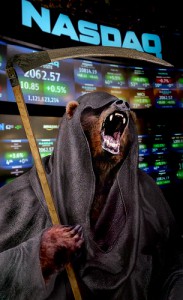Global Markets, Economies Mired in Early Stages of Biggest Disaster Ever
By Elliott Wave International
The following is a sample from Elliott Wave International’s new 40-page report, The State of the Global Markets — 2013 Edition: The Most Important Investment Report You’ll Read This Year. This article was originally published in Robert Prechter’s September 2012 Elliott Wave Theorist.
 Global markets and economies are mired in the early stages of the biggest disaster ever. Most people think both areas are in the early stages of a prolonged recovery, but in fact they are on the cusp of the second downturn, which will be of epic proportion.
Global markets and economies are mired in the early stages of the biggest disaster ever. Most people think both areas are in the early stages of a prolonged recovery, but in fact they are on the cusp of the second downturn, which will be of epic proportion.
The world is in the grip of a bear market. You wouldn’t know it from watching the S&P and the NASDAQ, but just about every other major market average in the world has been falling, including those of China, Japan, Europe, the BRICs, emerging markets, and even the broad U.S. market, shown in the chart below. And these indexes have fallen far further in inflation-adjusted terms.

Global-equity hedge funds, run by the smartest people in the business, have lost money for clients over the past 10 years. According to Income Research & Management and Bloomberg, over that time annual five-year returns have been up for two years, flat (0.0-0.8% gain) for three years, and negative for five years.
Our recommended short position in 2007-2009 gives us a positive five-year stock market experience. But we returned to a bearish stance too early. If we lived in China, our timing would have caught the exact top of the rally; if we lived in Europe, our current trade would be at a profit, too; but we don’t live in China or Europe. Only in the U.S. does the levitation continue, and even then it’s only in the blue-chip averages. The broad U.S. market, comprising all NYSE stocks, topped out nearly a year and a half ago, per the New York Composite Index shown at the bottom of the chart.
Market perversity is on display here, as both bulls and bears are suffering their own special water torture.
Many bullish fund managers have lost money since April 2011, because their portfolios tend to mirror the broad market. Garrett Jones reminded us that the most-owned stocks among institutions are down by a full one-third since 2000, as shown by the Institutional Index, a capitalization-weighted index of the 75 most-owned stocks by institutions (see the figure inside the State of the Global Markets report). Yet aggressive bears who shorted the S&P or NASDAQ have lost money, too, since the futures-related markets have risen.
It seems pertinent that only the indexes that one can leverage in quantity with futures — the S&P and NASDAQ — have risen over the past several months. Maybe this selectivity is for technical reasons, but there might be another explanation. Institutions, not the public, have driven the rally, and they can borrow billions of dollars from banks to leverage their bets. The divergent action among the indexes suspiciously fits the circumstance that major investment banks can make a lot of money by buying futures and then committing their own and clients’ funds to buying stocks that push up those particular underlying indexes. They could even sell other stocks to make it happen. Employing that strategy would account for the big differences in the averages over the past half-year. The low volume and volatility help serve up the opportunity. When the current plateau of optimism ends, the indexes now leading on the upside will catch up quickly on the way down. But in the meantime it’s an annoying situation, as momentum-based sell signals are flashing continually but the market has yet to succumb.
Adding to the injury is that fact that all of these indexes have been re-priced higher in dollar terms due to the temporary re-expansion of dollar-based credits since 2009. A chart on page 7 of The State of the Global Markets report shows the real path of stock values.
Most people seem to believe that the Fed has engineered the stock market rally. I also keep reading about how ECB President Mario Draghi is making stock markets go up by announcing bond purchases. This is wrong. As shown in the chart above, European stocks are below their highest level since the ECB bond-buying programs began. Likewise the largest debt-buying program the Fed ever undertook — a $1.3 trillion binge — occurred in 2008, and it failed to prevent the biggest bear market since 1932. The bear market ended three months after the Fed stopped the program. The Fed and the ECB are not the primary cause of optimism or rising stock prices. The rally was due for natural reasons, i.e., a swing toward more positive social mood, which our market forecasting publications anticipated. But QEs and other policies do provide big institutions with nearly unlimited credit, allowing them in optimistic times to put it to use. Doing so temporarily elevates prices beyond what they would be if unlimited credit weren’t available.
Optimism is necessary to allow the Fed and its banks to create credit for financial speculation, which keeps the market levitating. Conversely, when pessimism returns — as it soon will — the reduction of leverage will add to selling pressures.
Robert Prechter is the founder and president of Elliott Wave International, the world’s largest financial forecasting firm. The rest of EWI’s 40-page report, The State of the Global Markets — 2013 Edition: The Most Important Investment Report You’ll Read This Year, is available for download. Follow this link to download the full report – for free.
Image “Bear Market” by http://www.azrainman.com/


Leave a Reply